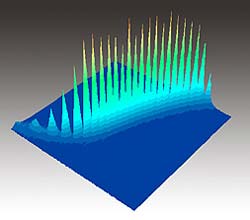Cell Phone Still Too Big? Micro-Oscillators May Help

A three-dimensional plot shows how the microwave frequency (x axis) generated by a new NIST oscillator varies with changes in the current (y axis). The height of each peak represents the power of the signal produced at specific frequencies.
A tiny, novel device for generating tunable microwave signals has been developed by researchers at the National Institute of Standards and Technology (NIST). Described in the Jan. 16 issue of Physical Review Letters, the device measures just a few micro-meters square and is hundreds of times smaller than typical microwave signal generators in use today in cell phones, wireless Internet devices, radar systems and other applications.
The device works by exploiting the fact that individual electrons in an electric current behave like minuscule magnets, each one with a “spin” that is either up or down, just as an ordinary magnet has a north and a south pole.
The NIST device consists of two magnetic films separated by a non-magnetic layer of copper. As an electric current passes through the first magnetic film, the electrons in the current align their spins to match the magnetic orientation in the film. But when the now aligned electrons flow through the second magnetic film, the process is reversed. This time the alignment of the electrons is transferred to the film. The result is that the magnetization of the film rapidly switches direction, or oscillates, generating a microwave signal. The microwave signal can be tuned from less than 5 gigahertz (5 billion oscillations a second) to greater than 40 GHz.
The NIST experiments confirm predictions made by theorists at IBM Corp. and Carnegie Mellon University in 1996.
NIST physicist William Rippard says the new oscillators can be built into integrated circuits with the same technologies now used to make computer chips and that they may eventually replace bulkier technologies at a greatly reduced cost.
Media Contact
More Information:
http://www.nist.gov/public_affairs/techbeat/tb2004_0116.htm#oscillatorAll latest news from the category: Physics and Astronomy
This area deals with the fundamental laws and building blocks of nature and how they interact, the properties and the behavior of matter, and research into space and time and their structures.
innovations-report provides in-depth reports and articles on subjects such as astrophysics, laser technologies, nuclear, quantum, particle and solid-state physics, nanotechnologies, planetary research and findings (Mars, Venus) and developments related to the Hubble Telescope.
Newest articles

Silicon Carbide Innovation Alliance to drive industrial-scale semiconductor work
Known for its ability to withstand extreme environments and high voltages, silicon carbide (SiC) is a semiconducting material made up of silicon and carbon atoms arranged into crystals that is…

New SPECT/CT technique shows impressive biomarker identification
…offers increased access for prostate cancer patients. A novel SPECT/CT acquisition method can accurately detect radiopharmaceutical biodistribution in a convenient manner for prostate cancer patients, opening the door for more…

How 3D printers can give robots a soft touch
Soft skin coverings and touch sensors have emerged as a promising feature for robots that are both safer and more intuitive for human interaction, but they are expensive and difficult…





















